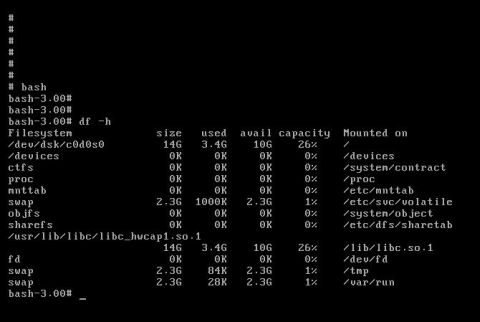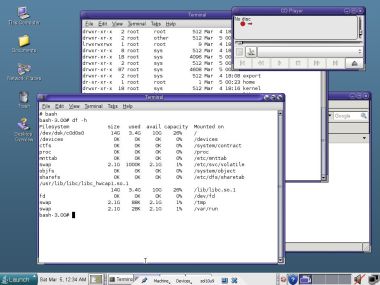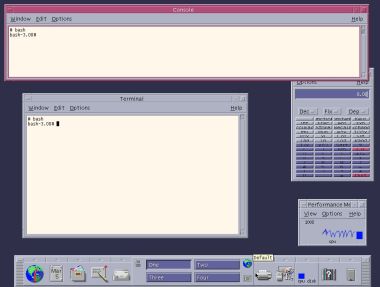Unix Operating System
What is Unix?
In this section we will discuss the Unix Operating System.
We will look at the different versions of Unix and discuss what makes this OS different from windows 7.
The Basics
We are looking at Operating Systems, and that's exactly what Unix is. An Operating System.
So, what makes the Unix operating system different from other OS's?.
Unix was created with multi user, multi tasking and security in mind.
It's renowned for it's command line interface. Unix's power lies in the CLI.
Engineers and system administrators also like the command line interface (CLI) that comes with Unix. It gives them more control over how the box is operated and managed.
Unix CLI (Solaris 10)
Large institutions such as banks and insurance brokers all run a version of Unix in their data centers. Which Unix they use is up to the technical team and job to to be done.
The most popular versions of the Unix operating system include, Oracle Solaris 10, IBM AIX and HP-UX. There are other versions, but these are the main players in the market.
Another great feature of Unix is that most of the software you need to run a server comes with the operating system. Mail server, web server, the file system, virtualization features etc are all built in the OS.
Solaris 10, for instance, has 3 different file systems bundled with the OS. You could use either SVM(Solaris Volume Manager), UFS(Unix File System) or ZFS(Zetabyte File System).
Solaris 10 also has virtualization software called zones or containers built in to the OS. You can create virtual machines out of the box.
AIX also has virtualization built in, in the form of LPars or Logical partitions.
One advantage of using Solaris is that you can install Solaris on either their own hardware platforms called SPARC, or you can download the x86 version that runs on Intel and AMD.
You can also download and use Solaris for free. If you need support though, you need to buy a support contract.
Solaris 10, in my opinion, is the better of the Unix's on offer because Sun Microsystems has been involved with Unix since the 1980's. Solaris has also been implemented on their SPARC platforms for a long time.
Solaris 10 with Java Desktop
Where did Unix start?
In 1969 a couple of guys at bell labs created the Unix operating system.
It was originally written in a computer language called assembly language, but in the 1970's it was rewritten in C.
Assembly is difficult to code and time consuming. So, re writing it in C made a lot of sense.
Why? well, very few people knew how to code in assembler. With the move to C it meant that more people could develop apps for Unix and it could also be more easily ported to other platforms.
That's exactly what happened. Today there are a lot of different version of the Unix operating system. One very popular product of this is, Linux.
Various variants of the Unix operating system were created. Solaris, AIX and HP-UX came from a variant called, BSD (Berkley Software Distribution). Other variants include System III, which later evolved to System V, also a very popular Unix.
So, does Unix only use CLI?
No, definitely not. But people working with the Unix operating system like to work in the command line interface.
In the beginning, the Unix front end or GUI was not pretty at all. Microsoft Windows concentrated on the look of the OS. That's probably why Windows became so popular.
The first real front end that was used for Unix was called, X window system. It was an open standard, so other companies also used it.
It wasn't as pretty as today's GUI's, but it got the job done. After all, engineers only needed the command line. With the X window system, they could now open multiple terminals and have multiple CLI sessions.
Solaris 10 with Common Desktop Environment
Later windowing system such as Motif, CDE (Common Desktop Environment) and Java Desktop versions were used.
Why doesn't everybody use Unix on their desktops?
Good question.
At some stage during Unix's development, the various organizations started having issues with each other. Standards issues. This company wanted to do things this way, that company wanted to do things that way.
Nobody could really come to an agreement on what the standards should be. So, some companies started to develop proprietary hardware and software.
At some stage, luckily, some companies did establish standards of which the well known IEEE is one.
In this time, Microsoft went all the way to get their DOS operating system licensed to IBM to be used on IBM's new personal computers.
I think another reason for people not using it is, it's complexity.
Windows made it very simple for someone to switch their computer on, click on some icons, and start working. Windows might not be the best OS there is, but it's GUI sure makes it look easy.
Let me show you an example. Below are some Solaris 10 commands on creating a file system with the zeta byte file system.
bash-3.00# zpool create newpool mirror c0t1d0 c1t0d0
This command creates a pool of 2 disks that's mirrored, meaning if one fails the other disk will continue.
To create a file system out of this pool you use the command zfs.
bash-3.00# zfs create -o mountpoint=/newfs /newpool/fs
You could have used the newpool mountpoint for data or create the file system like I showed in the example.
I used ZFS as an example, which is easy. If I used something like Solaris Volume Manager, it would have taken a lot more commands.
So, yes, Unix can be complex, but it's also very versatile and powerful.
You can download and play with either Solaris for x86 or Open Solaris at the Oracle website. Sun Microsystems was bought by Oracle a year or so ago, so don't try to go to Sun's website.
I hope I have given you some insight on the Unix operating system and how it works. It's a very broad subject, and I will make some pages available on this fascinating OS.
Return from Unix Operating System to Operating System
Back to What is My Computer